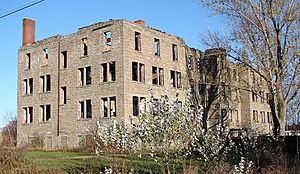Spanish Indian Residential Schools facts for kids
The Spanish Indian Residential Schools were two separate schools for Indigenous children in Spanish, Ontario. They operated from 1913 to 1965. One school was for boys and the other for girls. These schools were run by the Jesuits, the Daughters of the Heart of Mary, and the Government of Canada.
The boys' school was the only residential school in Canada run by the Jesuit order. Similarly, the girls' school was the only one run by the Daughters of the Heart of Mary. Together, the Spanish schools were the largest residential school in Ontario.
Contents
History of the Schools
How the Schools Started
Before the Spanish schools, the Jesuits ran a day school at Wiikwemkoong First Nation starting in 1838. In 1862, a girls' industrial school opened there. A boys' school followed in 1878, with help from the Canadian government.
In 1885, both schools at Wikwemikong were destroyed by fire. They were rebuilt and received government funding as residential schools. The boys' school was later moved to Spanish because of a disagreement with local workers.
In 1911, the girls' school at Wikwemikong also burned down. This led to the decision to move both schools to Spanish in 1913. Spanish was chosen because it was easier to reach by railway.
St. Peter Claver School for Boys
The St. Peter Claver School for Boys in Spanish, Ontario, was unique. It was the only residential school in Canada run by the Jesuits. The school had a large stone building and other buildings like a barn and sheds. It could house 180 boys. The school was located on a big 600-acre property near Lake Huron.
In 1947, a high school called Garnier High School (or Garnier College) was started at the boys' school. It was named after St. Charles Garnier, a famous missionary. Both schools were managed together as the Spanish Indian Residential School.
St. Joseph's School for Girls
The girls' school was named the St. Joseph's School For Girls. It moved to Spanish in 1913, next to the boys' school. Its building was finished in 1914.
The Daughters of the Heart of Mary continued to run this school. It was the only residential school in Canada operated by their order. During the 1918 flu epidemic, eight girls sadly died at St. Joseph's. The girls' school closed on June 30, 1962. The building was badly damaged by fire in 1981, but its outer walls still stand today.
When the Schools Closed
The girls' school closed in 1962. All the Spanish schools were closed by 1965. The Garnier building was taken down in 2004. The land for these schools was never owned by the Canadian government. It belonged to the Jesuits and the Daughters of the Heart of Mary.
Life at the Schools
Many students at the Spanish residential schools came from Indigenous communities. They came from places like Manitoulin Island, the shores of Lake Huron and Lake Superior. Students also came from Parry Sound, Ottawa Valley, Marathon, Chapleau, Temagami, and New Liskeard. Some students even came from other provinces, including Northern Quebec and Manitoba.
Students at the St. Joseph's School for girls have shared stories of difficult experiences. They talked about being treated poorly and losing their sense of who they were. To make them fit into a different culture, some nuns would only call students by numbers instead of their names.
Students at both Spanish schools had to work on the school's farm. Parents of the students often complained about the poor quality and lack of healthy food given to the children.
Author Basil H. Johnston wrote about his time at the Spanish residential schools. His book, Indian School Days, was published in 1988. Wilmer Nadjiwon, an Indigenous activist, also spoke about the mistreatment he faced at the St. Peter Claver Residential School.
Remembering the Schools
The first reunion for students of the Spanish residential schools happened in 1988.
In 2009, a monument was built to remember the students of the Spanish Schools. In 2010, artist Stacy Sauve began decorating a tree across from the St. Joseph school site as a memorial. The tree features images of two elders and a thunderbird.
Images for kids
See also



